
Am Fam Physician. 2018;97(11):online
See related article on diets for health
A healthy diet has a lot of benefits. It can prevent certain health conditions like heart disease and cancer, and it can lower your cholesterol. It can give you more energy, help you focus, and improve your mood. It can also help you lose weight or stay at a healthy weight.
Path to Improved Health
The choices you make about what you eat and drink matter. They should add up to a balanced, nutritious diet. We all have different calorie needs based on our age, sex, and activity level. Health conditions can have a role, too.
Fruits and Vegetables
Fruits and vegetables are rich in fiber, vitamins, and minerals. They should be the basis of your diet. Try to get many different colors of fruits and vegetables each day to add flavor and variety. Fruits and vegetables should cover half of your plate at each meal. Try not to add saturated fats and sugar to vegetables and fruits. This means avoiding margarine, butter, mayonnaise, and sour cream. You can use yogurt, healthy oils (such as canola or olive oil), or herbs instead. Potatoes and corn are not considered vegetables. Your body processes them more like grains.
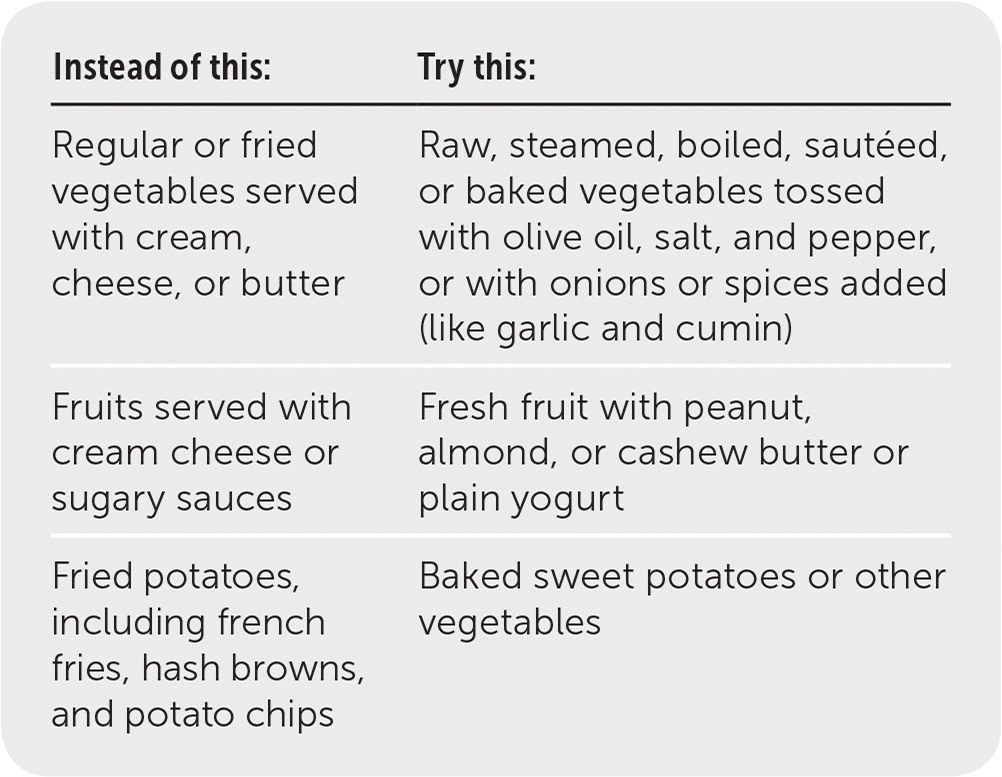
| Instead of this: | Try this: |
|---|---|
| Regular or fried vegetables served with cream, cheese, or butter | Raw, steamed, boiled, sautéed, or baked vegetables tossed with olive oil, salt, and pepper, or with onions or spices added (like garlic and cumin) |
| Fruits served with cream cheese or sugary sauces | Fresh fruit with peanut, almond, or cashew butter or plain yogurt |
| Fried potatoes, including french fries, hash browns, and potato chips | Baked sweet potatoes or other vegetables |
Grains
Choose products that list whole grains as the first ingredient. Whole grains are high in fiber, protein, and vitamins. They are digested slowly, which helps you feel full longer and keeps you from overeating. Avoid products that say “enriched.”
Hot cereals like oatmeal are usually low in saturated fat. However, instant cereals with cream may contain processed oils and can be high in sugar. Granola cereals usually contain a lot of sugar. Cold cereals are generally made with refined grains and are high in sugars. Look for whole-grain, low-sugar options instead.
Try not to eat rich sweets, such as doughnuts, rolls, and muffins. Consider fruit or a piece of dark chocolate instead to satisfy your sweet tooth.
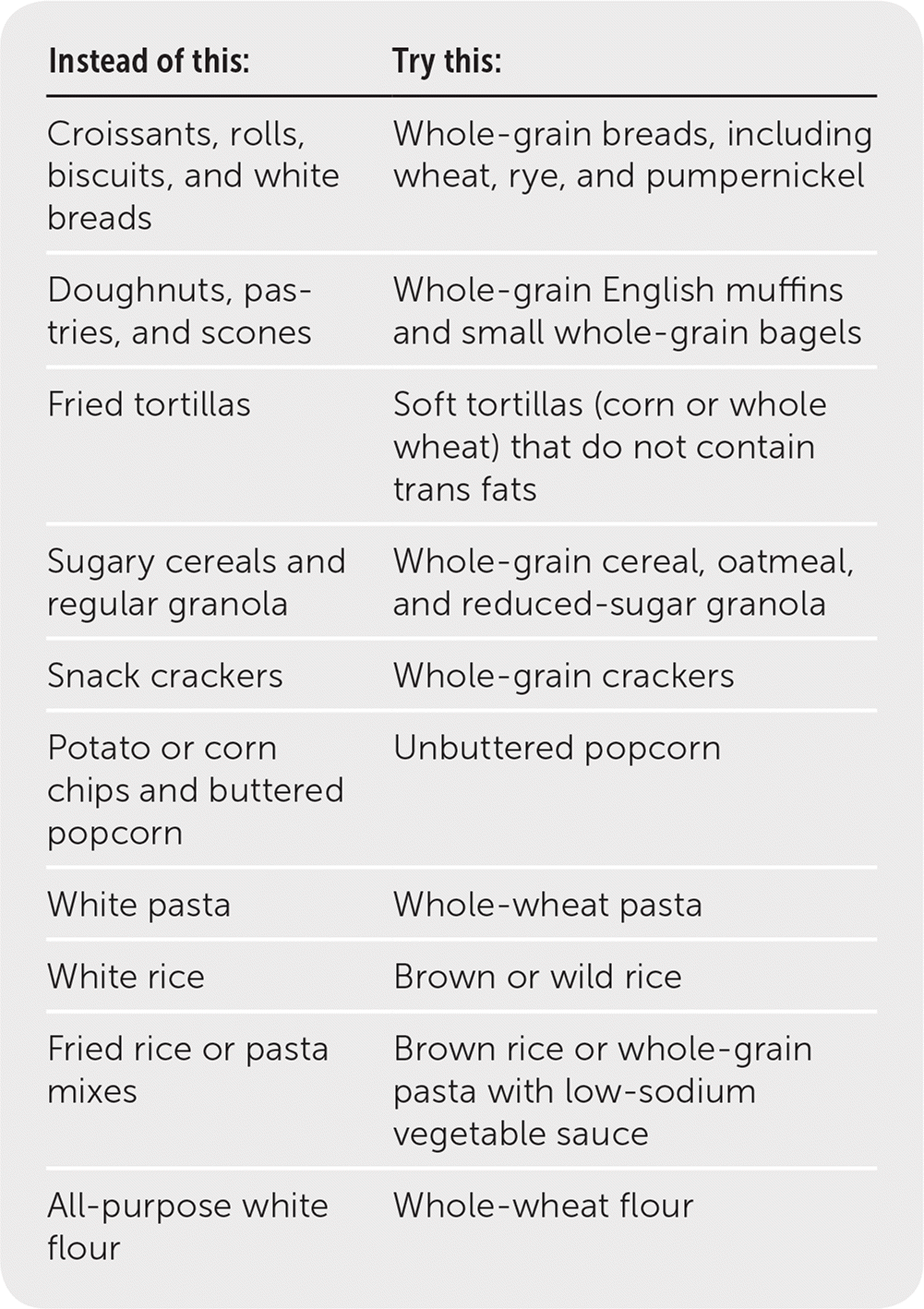
| Instead of this: | Try this: |
|---|---|
| Croissants, rolls, biscuits, and white breads | Whole-grain breads, including wheat, rye, and pumpernickel |
| Doughnuts, pastries, and scones | Whole-grain English muffins and small whole-grain bagels |
| Fried tortillas | Soft tortillas (corn or whole wheat) that do not contain trans fats |
| Sugary cereals and regular granola | Whole-grain cereal, oatmeal, and reduced-sugar granola |
| Snack crackers | Whole-grain crackers |
| Potato or corn chips and buttered popcorn | Unbuttered popcorn |
| White pasta | Whole-wheat pasta |
| White rice | Brown or wild rice |
| Fried rice or pasta mixes | Brown rice or whole-grain pasta with low-sodium vegetable sauce |
| All-purpose white flour | Whole-wheat flour |
Protein
Protein can come from animal and vegetable sources. People who get more of their protein from animal sources tend to have more health problems that can lead to illness and early death.
It is healthier to eat meat less often and get most of your protein from plant sources. When you eat meat, choose leaner cuts.
Vegetable Protein Sources
There are many ways to get protein in your diet even if you do not eat meat. Most vegetables have some protein. When you eat these vegetables with whole grains, seeds, nuts, and especially beans, you can get a good amount of protein. You can swap beans for meat in recipes like lasagna or chili. Soy foods such as tofu, tempeh, and edamame are also good sources of protein.
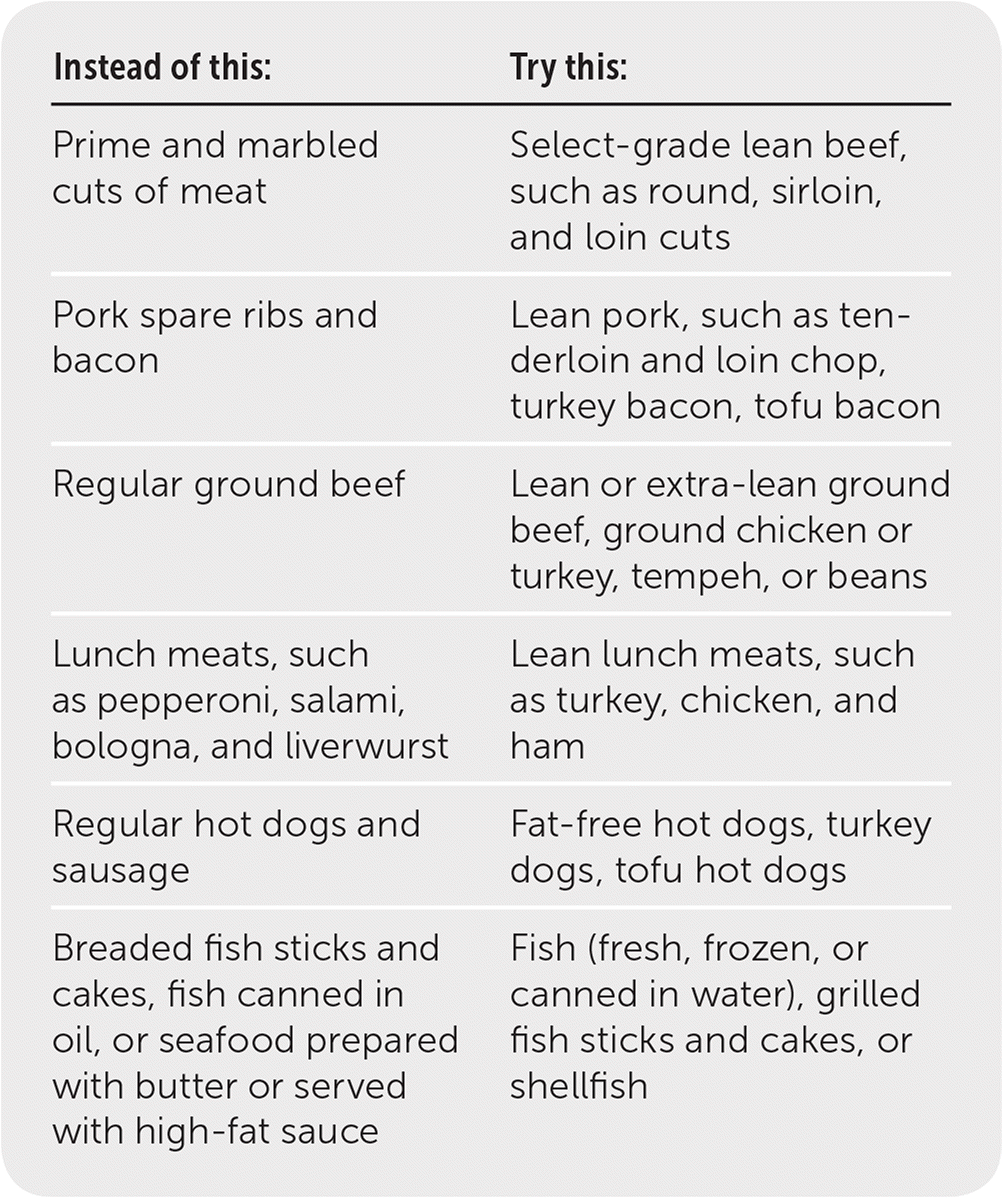
| Instead of this: | Try this: |
|---|---|
| Prime and marbled cuts of meat | Select-grade lean beef, such as round, sirloin, and loin cuts |
| Pork spare ribs and bacon | Lean pork, such as tenderloin and loin chop, turkey bacon, tofu bacon |
| Regular ground beef | Lean or extra-lean ground beef, ground chicken or turkey, tempeh, or beans |
| Lunch meats, such as pepperoni, salami, bologna, and liverwurst | Lean lunch meats, such as turkey, chicken, and ham |
| Regular hot dogs and sausage | Fat-free hot dogs, turkey dogs, tofu hot dogs |
| Breaded fish sticks and cakes, fish canned in oil, or seafood prepared with butter or served with high-fat sauce | Fish (fresh, frozen, or canned in water), grilled fish sticks and cakes, or shellfish |
Beef, Pork, Veal, and Lamb
Lean beef and veal cuts have the words “loin” or “round” in their names. Lean pork cuts have the words “loin” or “leg” in their names. Trim off the outside fat before cooking the meat. Trim any inside fat before eating it. Use herbs, spices, and low-sodium marinades to season meat.
Baking, broiling, grilling, and roasting are the healthiest ways to cook meats. Lean cuts can be panbroiled or stir-fried. Use a nonstick pan, canola oil, or olive oil instead of butter or margarine. Don't serve meat with high-fat sauces and gravies.
Poultry
Chicken breasts are a good choice because they are low in fat and high in protein. Only eat duck and goose once in a while, because they are higher in saturated fat. Remove skin and visible fat before cooking. Baking, broiling, grilling, and roasting are the healthiest ways to cook poultry. Skinless poultry can be pan broiled or stir fried. Use a nonstick pan, canola oil, or olive oil instead of butter or margarine.
Seafood
Most seafood is high in healthy polyunsaturated fats. Healthy omega-3 fatty acids also are found in some fish, such as salmon and cold-water trout. If good-quality fresh fish isn't available, buy frozen fish. To prepare fish, you should poach, steam, bake, broil, or grill it.
Dairy
Choose low-fat, skim, or nondairy milk, such as soy, rice, or almond milk. Try low-fat or part-skim cheeses and other dairy products, or choose smaller portions of foods high in saturated fat.
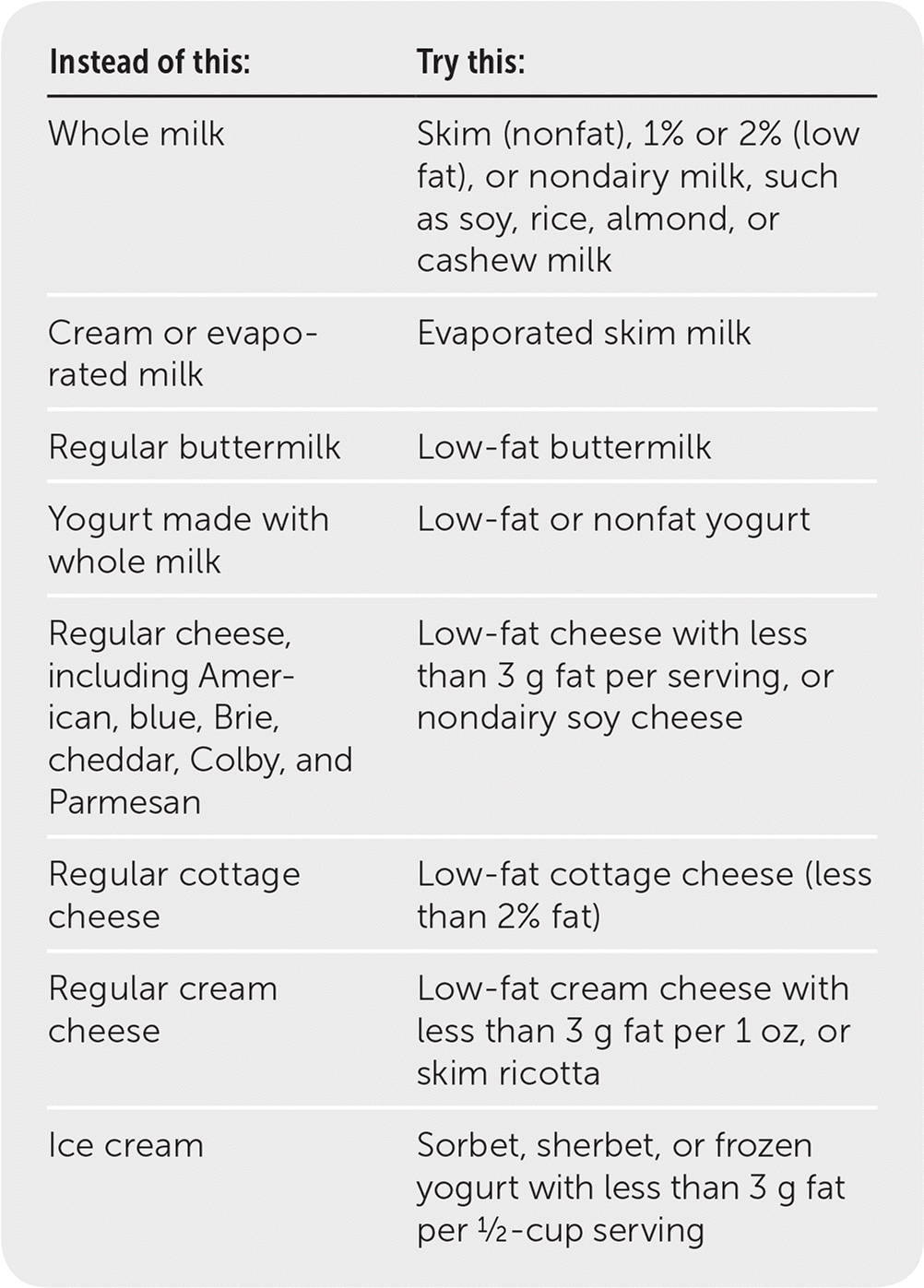
| Instead of this: | Try this: |
|---|---|
| Whole milk | Skim (nonfat), 1% or 2% (low fat), or nondairy milk, such as soy, rice, almond, or cashew milk |
| Cream or evaporated milk | Evaporated skim milk |
| Regular buttermilk | Low-fat buttermilk |
| Yogurt made with whole milk | Low-fat or nonfat yogurt |
| Regular cheese, including American, blue, Brie, cheddar, Colby, and Parmesan | Low-fat cheese with less than 3 g fat per serving, or nondairy soy cheese |
| Regular cottage cheese | Low-fat cottage cheese (less than 2% fat) |
| Regular cream cheese | Low-fat cream cheese with less than 3 g fat per 1 oz, or skim ricotta |
| Ice cream | Sorbet, sherbet, or frozen yogurt with less than 3 g fat per ½-cup serving |
Yogurt can replace sour cream in many recipes. It is important to pick yogurt without added sugar. Try mixing yogurt with fruit for dessert. Sorbet and frozen yogurt are lower in fat than ice cream.
Fats and Oils
Although high-fat foods are higher in calories, they can help you feel satisfied with eating less. Don't be afraid to have fats in your diet, but try to limit saturated and trans fats. You need saturated and unsaturated fats in your diet, but most Americans get too much saturated fat. Heart disease, diabetes, some cancers, and arthritis have been linked to diets high in saturated fat, particularly saturated fats from animal products.
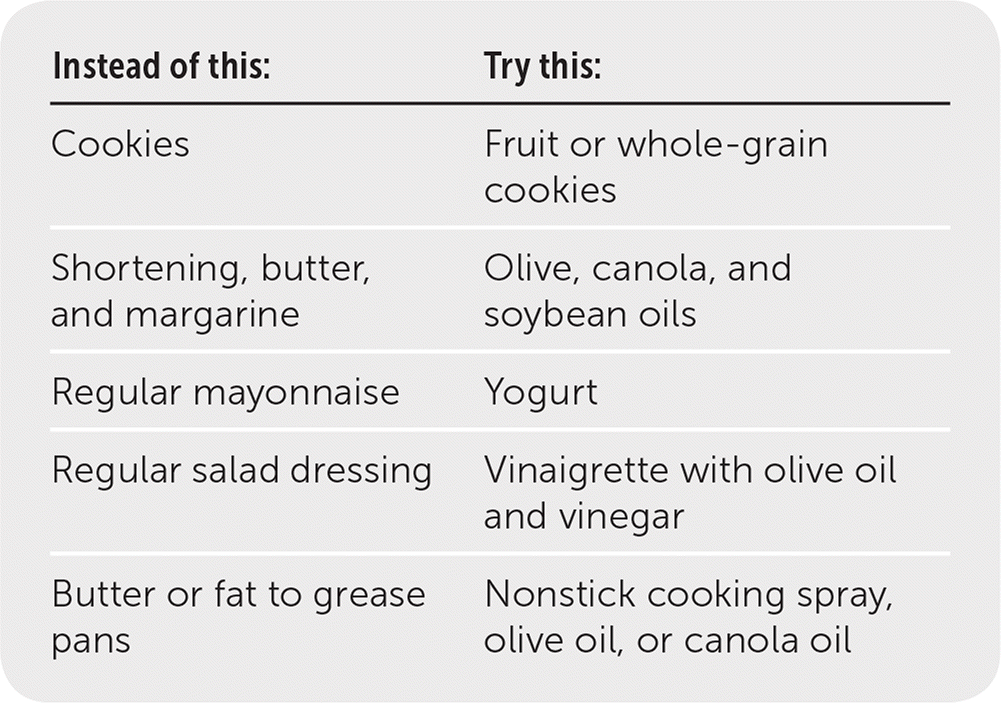
| Instead of this: | Try this: |
|---|---|
| Cookies | Fruit or whole-grain cookies |
| Shortening, butter, and margarine | Olive, canola, and soybean oils |
| Regular mayonnaise | Yogurt |
| Regular salad dressing | Vinaigrette with olive oil and vinegar |
| Butter or fat to grease pans | Nonstick cooking spray, olive oil, or canola oil |
Beverages
It is important that you stay hydrated. However, drinks that contain sugar are not healthy. This includes fruit juices, soda, sports and energy drinks, sweetened or flavored milk, and sweet tea. Artificial sweeteners may also be bad for your health. Drink mostly water or other unsweetened drinks. Don't drink too much alcohol. Women should have no more than one drink per day. Men should have no more than two drinks per day.
Questions to Ask Your Doctor
How many servings should I eat from each food group?
If I'm on a strict diet, such as vegetarian or vegan, how can I make healthy food choices?
More information
American Academy of Family Physicians Patient Information Resource
Harvard University Healthy Eating Plate
U.S. Department of Agriculture, Choose My Plate
